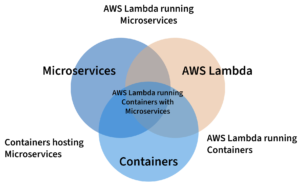Are AWS Lambda and Microservices the Same Thing?
AWS Lambda vs microservices … What’s the difference? They are both popular approaches for building scalable and efficient applications in the cloud. While they share some similarities, they have distinct differences that make them better suited for different use cases. In this article, we will compare AWS Lambda and microservices to help you choose the best approach for your application.
AWS Lambda Overview
AWS Lambda is a serverless compute service offered by Amazon Web Services (AWS) that allows you to run your code without provisioning or managing servers. You only pay for the compute time that you consume, making it a cost-effective solution for running applications with unpredictable or infrequent usage patterns. Lambda functions are event-driven, meaning they are triggered by specific events, such as changes to data in a database or messages in an queue.
Microservices Overview
Microservices, on the other hand, are a software architecture pattern where an application is broken down into a collection of small, independent services that communicate with each other via APIs. Each microservice is responsible for a specific task, and can be developed, deployed, and scaled independently from the others. This allows for greater agility and flexibility in developing and deploying complex applications.
Are AWS Lambdas the Same as Microservices?
Let’s say you have two separate pieces of business logic. One of them is updating your profile in an application, and the other is sending a message to another user. In a straight-up microservice architecture that does NOT use AWS Lambdas, each of those functions is accomplished by a separate service. So, you have a user authentication service and a user messaging service. Each of those services runs on a server in a datacenter somewhere all the time. Someone needs to monitor and maintain those servers to make sure they’re always working. Otherwise, if they crash, users who are trying to log in or send a message won’t be able to and they’ll think your app is broken. And … it is.
Well, you could put each of those functions into an AWS Lambda. Now you have a Lambda with your logic for logging in and another Lambda with your logic for sending a message. AWS, as the cloud provider does not have servers running these services all the time. What happens is that when your user authenticates or sends a message, it triggers an event on AWS’s hardware that says, “Spin up this authentication service because someone needs to use it.” The same thing happens with the messaging service. Once users are done with these functions, they terminate.
Can you use AWS Lambda in a Microservice Architecture?
Yes! Lambda functions are wonderful for microservice architecture. You can put each microservice into its own Lambda. That’s called a “single purpose function.” You can develop, deploy, and scale each microservice separately from the others. And as for scaling, you don’t have to worry about that, since AWS scales it automatically for you.
Another benefit of using AWS Lambdas with a microservice architecture is that Lambdas are easily used in layers, making shared, reusable code easily available to multiple functions. You can learn more about that by reading or watching AWS Lambda Layers.
Can AWS Lambda Have Multiple Functions?
Yes. Single purpose functions are not the only ways to use Lambdas. You can have a Lambda that has a whole Docker container in it with more than just a single function. In fact, according to the Datadog 2022 State of Serverless Report, one in five lambda customers packages and deploys functions as container images. To learn more about this, read or watch Can AWS Lambda Run a Docker Container?
Let’s top all this technical talk with a Venn diagram.

Basically, lambda functions can run microservices and containers, but not all lambda functions have microservices. Some do, some don’t. The same thing could be said for containers. You can even have a Lambda run a container hosting a microservice.
So, the very concept of AWS lambda vs microservices is something of a misnomer. They’re not mutually exclusive. One is a compute service and the other is an architectural pattern. They can be used together.
Pros and Cons of AWS Lambda Functions vs Microservices
Scalability: Both AWS Lambda and microservices are designed for scalability, but they achieve it in different ways. Lambda functions automatically scale to meet demand, without the need for manual configuration. Scaling microservices requires more planning and management, as each service needs to be deployed and scaled independently.
Cost: AWS Lambda’s pay-as-you-go model can be more cost-effective than running and managing a fleet of servers for microservices. However, if you have a high and consistent workload, microservices may be more cost-effective in the long run.
Deployment: Deploying a Lambda function is a simple process, as you only need to upload your code to AWS and configure the triggers. Deploying microservices, on the other hand, requires more setup and management, as each service needs to be deployed and managed separately.
Architecture: AWS Lambda is a function-as-a-service (FaaS) platform, while microservices are a software architecture pattern. Lambda functions are designed to be small, stateless, and focused on a single task, while microservices are larger and more complex, with their own data stores and business logic.
They’re both powerful approaches for building scalable and efficient applications in the cloud. Lambda is a great choice for small, stateless functions that are triggered by specific events, while microservices are a better fit for complex, data-intensive applications that require more control over the architecture. Ultimately, the choice between AWS Lambda and microservices depends on your specific needs and use case.



0 Comments